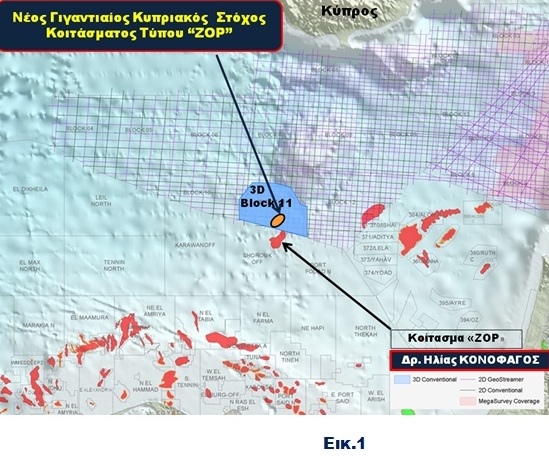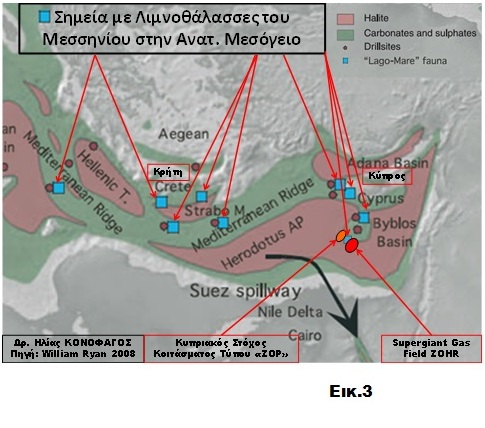23801 - Target Zohr field of Cyprus overturns all geopolitical balances. (with E. Conophagos and A. Foscolos)
E. Conophagos, N. Lygeros, A. Foscolos
Translated from the Greek by Vicky Baklessi
Some weeks ago we had pointed out that the discovery of the Supergiant biogenic gas field Zohr in offshore block 9 of Egypt’s EEZ constitutes – from a geological perspective- an unprecedented discovery and an innovation in the Eastern Mediterranean. We noted also that the Egyptian field Zohr with a scale of proven reserves of 26 Trillion cubic feet of natural gas was created in paleolagoon borders during the Miocene period, something that opens up new significant geological prospective for fields discoveries so much in the EEZ of Cyprus as well as in the EEZ of Greece.
Just before the ink dried out on our publications, Solon Kassinis and Elias Konofagos presented during the International Conference MARE FORUM in Athens the expected targets of new giant karstified limestone fields of type Zohr so much in the EEZ of Cyprus as as well in the EEZ of Greece.
The first and most significant fact seems to be today the new Cypriot target of the Zohr type field which is located entirely within the Cypriot EEZ and has been recently mapped by the French company “TOTAL” (Img 1)
This target is considered today scientifically mature for drilling, the characteristics of this field being described very briefly in the following:
• The Cypriot Zohr is located within the offshore block 11 .
• The base of the Cypriot target of type Zohr seems to be in a distance of just 5 kilometers from the base of the Egyptian field Zohr.
• The Egyptian field Zohr is almost filled with natural gas
• The possibility of a new type Zohr field to be discovered in the entire height of its structure (around 660 meters, pay zone) something exceptionally rare even on a global scale. This of course leads to the conclusion that the organic substance which the exceptionally saline paleolagoons of the Mediterranean created huge quantities of pure natural gas which satisfactorily fed the paleohigh reservoirs of karstified limestone of the Miocene period.
• The probability of a new field of type Zohr to be discovered in Cyprus-full of natural gas- by the company TOTAL in the offshore block 11, should in our opinion exceed 70%.
• As known the existence of watertight sheets of evaporites of the Messinian which exist in the peaks of the structures ensures completely their tightness of seal this way ensuring high pressure supplies of natural gas to the drilling productions. This property leads almost always to much lower development cost of the fields. Especially today that we are in a period of low oil and gas prices, this factor is quite significant.
• In the case that there is the discovery of a field by TOTAL in the offshore block 11, the infrastructure of offshore facilities of the Egyptian field Zohr of the Italian company ENI that are anticipated in the area within 2019, will allow the exploitation of the new Cypriot field with a much lower cost.
• The expected probable reserves of the Cypriot Zohr are estimated in our opinion today, to be at least 15 Trillion cubic feet of natural gas (triple that of Aphrodite’s) while the respective possible reserves could reach 28 Trillion cubic feet.
• The above probable reserves – which represent today’s needs of Greece in natural gas for about 100 years – could contribute drastically so much in the development of pipelines transferring natural gas from Cyprus towards the European Union via Greece but also to the substantial resolution of the Cypriot question.
In conclusion we would like to point out that in Greece unfortunately we continue to operate as mere observers of the energy development of the fields of Cyprus, Israel and Egypt. Our tactics focus exclusively in energy imports from third world countries. There seems to be absolutely no effort in highlighting our probable resources South of Crete, which not only have reasonable probabilities to provide significant reserves of natural gas to our country but could also provide significant synergies for the enhancement or even co-exploitation of natural gas fields with those of Cyprus, Egypt and Israel.
According to all indications from our previous publications there surely are respective to that of Cyprus and Egypt prospective of locating significant new fields of type Zohr in Greece as well.
Recent exploration cooperations of petroleum companies with the Universities of Columbia of USA and Utrecht in the Netherlands proved that South of Crete paleogeographically there were at least 5 positions of paleolagoons of the Miocene period in areas where there are certainly reasonable probabilities for the presence of natural gas fields of type Zohr within the Greek EEZ. (see Img 3.)



